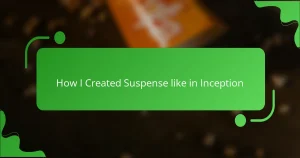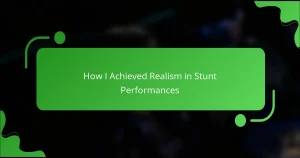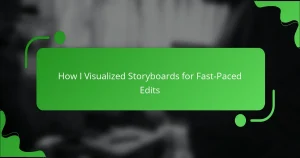Key takeaways
- Action short films focus on quick, adrenaline-driven storytelling, often prioritizing immediate thrills over deep character development.
- Soundtracks play a crucial role in enhancing the emotional impact of action scenes, with techniques such as sound layering, dynamic manipulation, and effective use of silence.
- The right gear, including digital audio workstations and studio monitors, is essential for creating immersive soundscapes that match the visuals.
- Collaboration with peers and directors enriches the creative process, leading to innovative ideas and improved sound design.
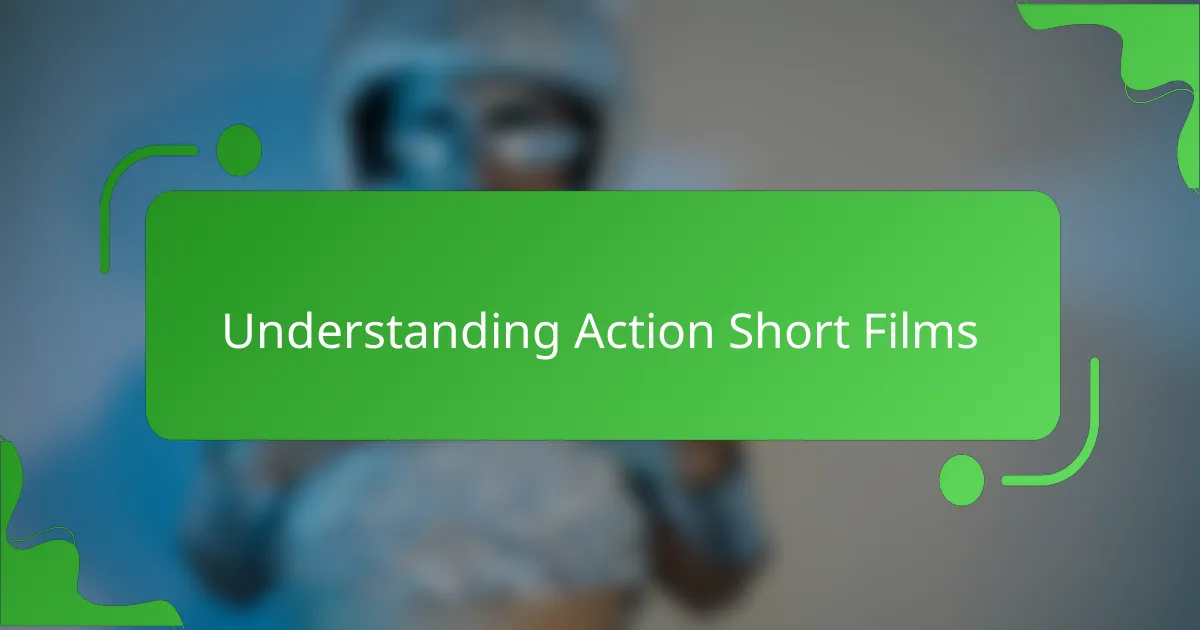
Understanding Action Short Films
Understanding action short films requires an appreciation for their unique storytelling style. In my experience, these films concentrate on adrenaline-fueled moments, often compressing tension and excitement into a few brief minutes. I’ve seen how soundtracks play a pivotal role in amplifying emotions, making viewers feel every thrill and pulse.
One aspect I find fascinating is how action scenes demand a specific rhythm—much like a heartbeat. From my own work, I recall a time when I adjusted the tempo of a scene to match the escalating intensity. This synchronization can transform a good moment into an unforgettable one.
The below comparison table outlines some key characteristics of action short films versus traditional action feature films, highlighting their unique approaches in storytelling and pacing.
| Characteristic | Action Short Films | Action Feature Films |
|---|---|---|
| Length | Typically under 20 minutes | Usually 90-150 minutes |
| Pacing | Fast, with a focus on immediate thrills | Varied pacing, includes character development |
| Story Depth | Often superficial, prioritizing action over plot | More in-depth story arcs |
| Character Development | Minimal, quick introductions | In-depth exploration of characters |
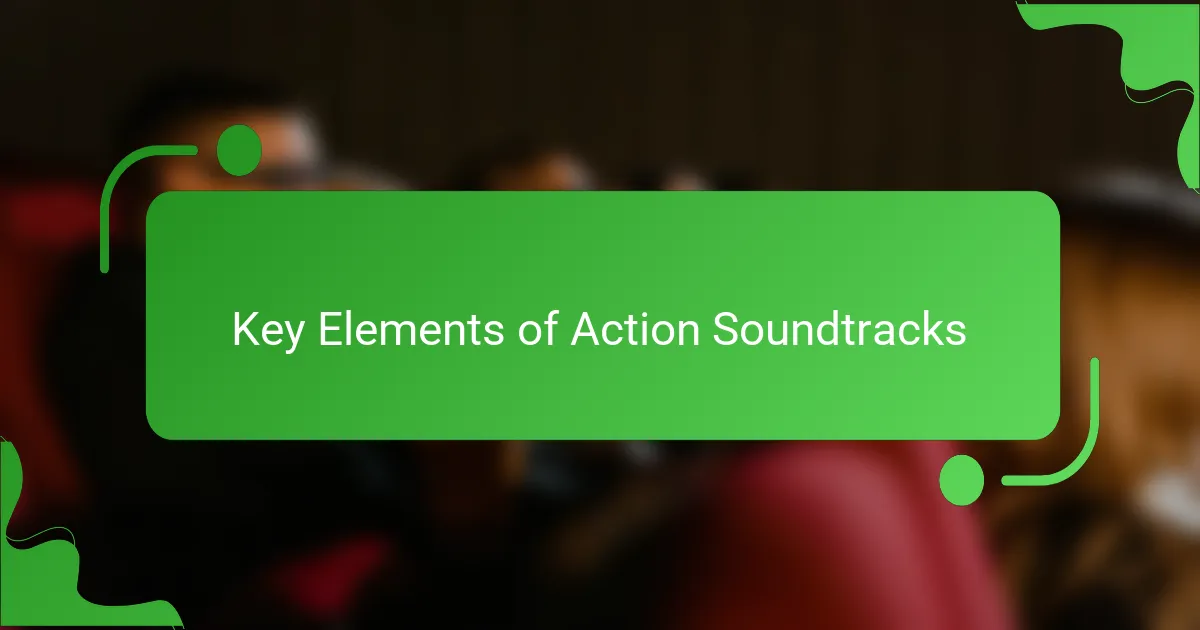
Key Elements of Action Soundtracks
When I think about the key elements of action soundtracks, the first thing that comes to mind is intensity. The sound design needs to reflect the high stakes of each moment; otherwise, the excitement falters. For example, during a chase scene I worked on, layering bass-heavy sounds with sharp, high-pitched effects created a palpable tension that kept viewers on the edge of their seats.
Another crucial aspect is variation. A well-crafted soundtrack combines different musical styles and sound layers to maintain engagement. I often experiment with sudden shifts from calm melodies to frantic rhythms, signifying crucial plot twists. Just like in life, where we experience a mix of emotions, incorporating this variability can elicit a more profound response from the audience.
Finally, let’s not overlook the significance of silence. It may seem counterintuitive in action scenes, but carefully placed pauses enhance dramatic moments. I recall a scene where I intentionally dialed back the sound, allowing the tension to build before an explosive climax. This contrast not only magnified the action that followed but also left viewers breathless. Don’t you find it intriguing how silence can be as powerful as music?
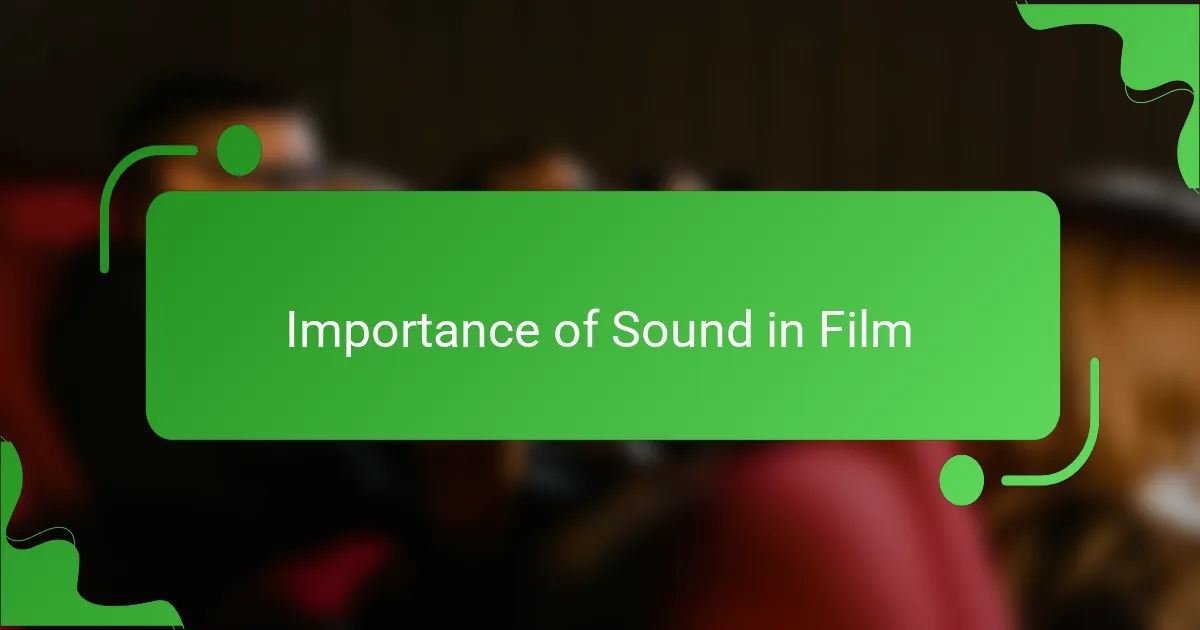
Importance of Sound in Film
Sound is a fundamental element in film that shapes the viewer’s experience. I often say that sound is not just an accompaniment; it’s the heartbeat of a scene. I remember working on a project where the sound of footsteps in a tense moment heightened the suspense far beyond what visuals alone could convey. It’s incredible how the right sound can pull you deeper into the narrative.
Moreover, sound can transform the mood entirely. In one particular action scene, I experimented with different audio effects, and it amazed me how a slight tweak in the backdrop could shift the scene from exhilarating to terrifying. Isn’t it fascinating to think that a few layered sounds can manipulate our emotions so effectively? I’ve found that the delicate balance of sound can really elevate a film’s emotional impact.
There’s also the undeniable power of sound design that influences the audience’s perception of danger and excitement. I once mixed in a low rumbling sound during an explosive reveal, and the thrill in the room was palpable. It reminded me that sound is not merely heard; it’s felt. Can you imagine what action films would be like without that rich soundscape? It certainly makes me appreciate the artistry behind sound design even more.
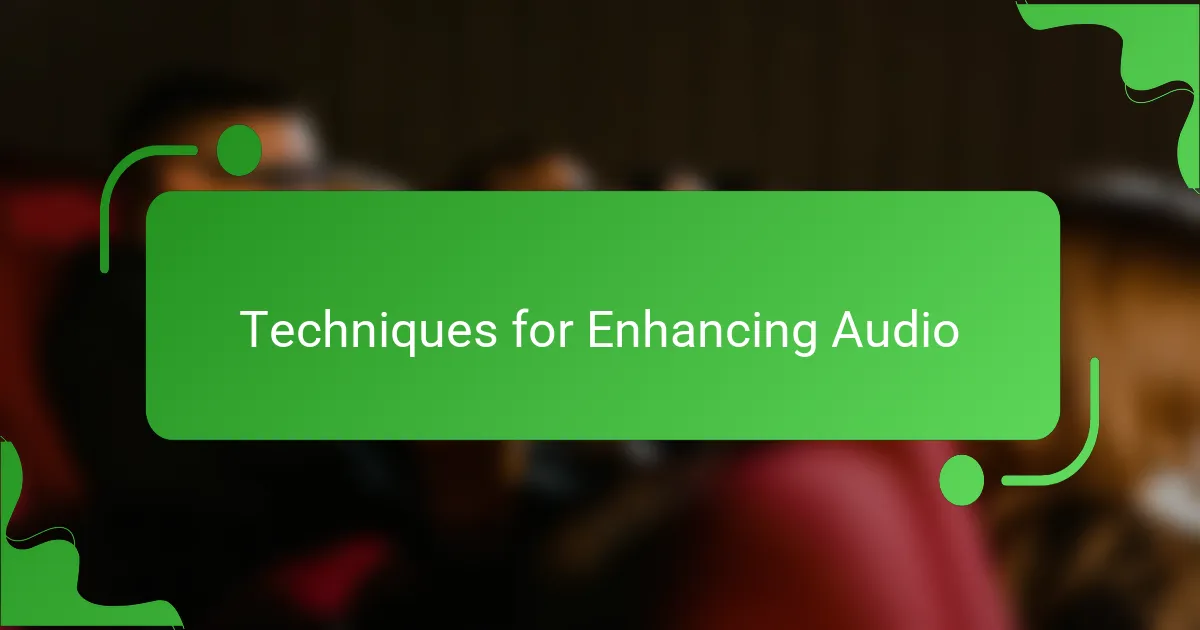
Techniques for Enhancing Audio
Techniques for enhancing audio play a crucial role in making an action scene feel more intense and immersive. One technique I often use is layering sounds. For instance, I create a base sound layer of ambient noise, like city sounds or thunder, and then add sharp, impactful sound effects, such as explosions or punches, on top of that. This layering creates a rich audio tapestry that grips the viewer’s attention and elevates the urgency of the scene.
Another effective method is to manipulate the dynamics of audio. I remember working on a chase scene where I utilized crescendos to build excitement, matching the ebb and flow of the visual action. The audio swells make viewers feel more invested in the characters’ struggles, amplifying the sense of urgency. It’s all about crafting an atmosphere that resonates emotionally with the audience, drawing them deeper into the experience.
Lastly, careful use of Foley can enhance realism. For one project, I recorded my own footsteps in various environments to ensure they synced perfectly with the characters on screen. This attention to detail not only elevates the sound quality but also immerses the audience in the film’s world.
| Technique | Description |
|---|---|
| Layering Sounds | Combining ambient noises with impactful sound effects. |
| Dynamic Manipulation | Using crescendos to mirror the visual intensity of action. |
| Foley Recording | Creating realistic sound effects that sync with on-screen actions. |
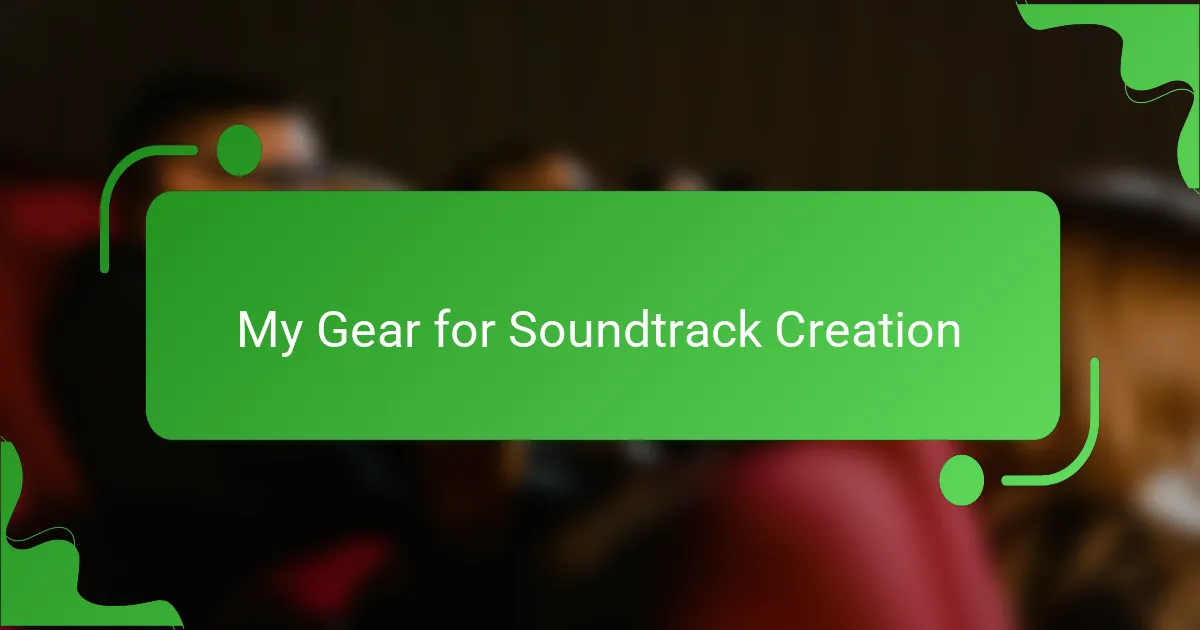
My Gear for Soundtrack Creation
When it comes to creating soundtracks for action scenes, the right gear makes all the difference. I primarily use a digital audio workstation (DAW), which lets me layer sounds and refine my audio tracks seamlessly. I remember the first time I used a synthesizer to create an explosion sound—there was something so exhilarating about hearing it come to life in sync with the visuals.
For me, studio monitors are essential. They allow me to listen to my mixes accurately, ensuring every heartbeat and footstep in the scene resonates with the intended intensity. It’s like having a window into the sound world I’m building. I still can’t forget the thrill of adjusting the EQ settings and finally getting it just right; it felt like crafting magic.
Here’s a comparison of my gear that highlights their roles:
| Equipment | Purpose |
|---|---|
| Digital Audio Workstation (DAW) | For layering and editing sound tracks |
| Synthesizer | For creating unique sound effects |
| Studio Monitors | For precise audio playback |
| Microphone | For capturing live sounds |
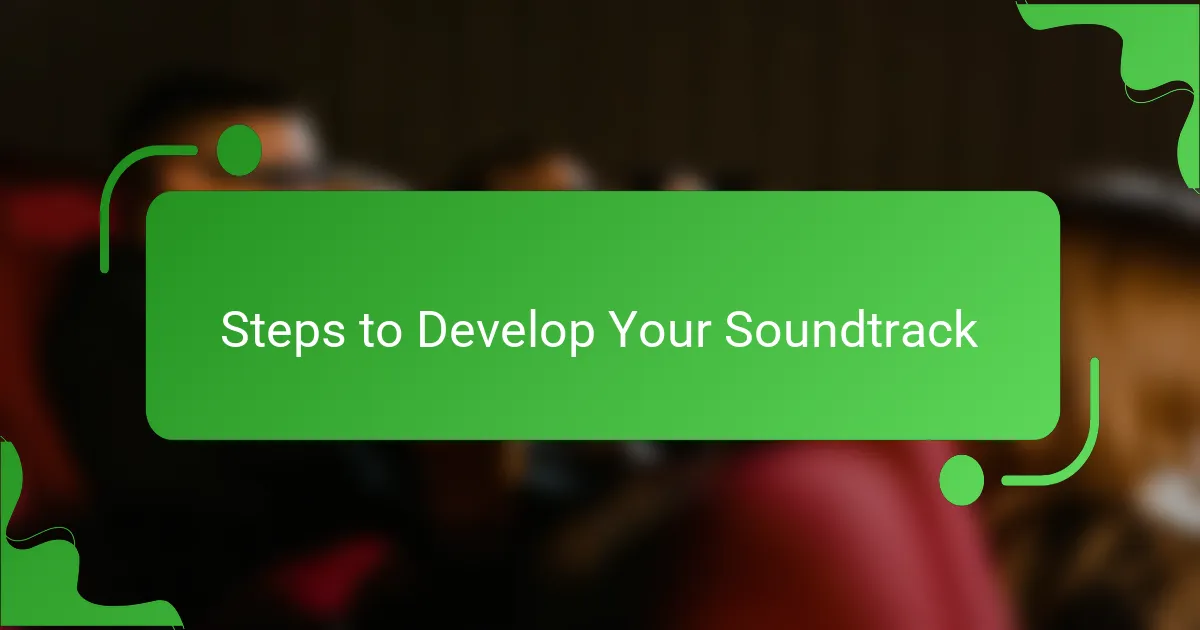
Steps to Develop Your Soundtrack
When developing your soundtrack, I find it essential to begin with a concept that reflects the scene’s emotion. For instance, I often ask myself, “What feelings do I want the audience to experience?” This guiding question helps shape the sound choices I make. In my case, I once focused on creating a sense of desperation in a high-stakes chase scene, using frenetic rhythms that mimicked a racing heartbeat.
Next, I suggest experimenting with various sound textures. Mixing orchestral elements with electronic sounds can create a unique sonic landscape. I remember blending strings with synthesized bass for a climactic showdown in one of my projects. The contrast not only heightened the intensity but also added depth to the action, making it feel fresh and engaging. Isn’t it amazing how diverse sounds can evoke different emotions?
Finally, never underestimate the power of feedback. Once, after sharing my initial mix with peers, I received valuable insights that led me to adjust the soundtrack for better pacing. These collaborative moments can enrich your work and ensure that your soundtrack resonates with others. Do you collaborate with others? If not, I highly recommend it! It opens up new perspectives and enhances your creativity.
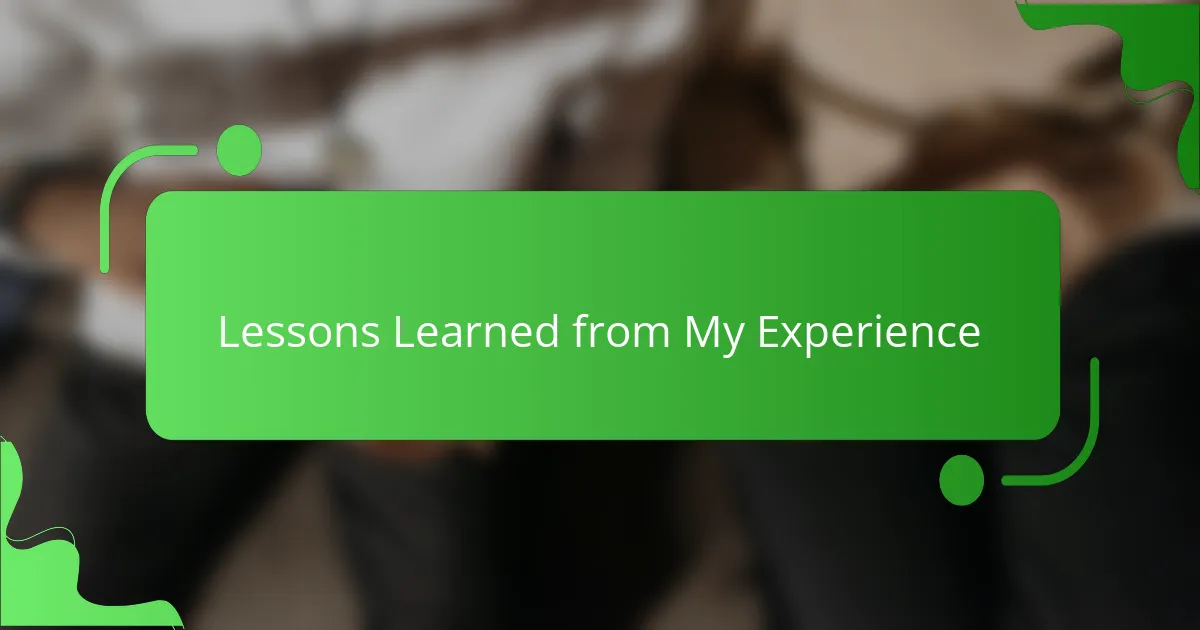
Lessons Learned from My Experience
When enhancing the soundtrack for an action scene, one significant lesson I learned is the importance of matching the music’s tempo to the on-screen action. I remember one particular project where I had a fast-paced sequence, and using an intense, driving score elevated the tension remarkably. It made the scene more immersive—not just for the audience, but for me as I witnessed the transformation firsthand.
Another key insight involves experimenting with sound effects. I once layered subtle, ambient sounds beneath the music to create depth and realism. This not only enriched the viewing experience but also allowed me to connect more emotionally with the scenes, as I saw how sound could evoke fear, excitement, and anticipation.
The collaborative aspect is also vital. Working with the director to understand their vision made a huge difference. The back-and-forth discussions led to brilliant ideas that I hadn’t initially considered, proving that teamwork can really enhance the creative process.
| Lesson | Description |
|---|---|
| Match Tempo | Aligning music pace with action improves tension and immersion. |
| Experiment with Sound Effects | Layering ambient sounds adds depth and emotional resonance. |
| Embrace Collaboration | Working closely with the director opens the door to innovative ideas. |
